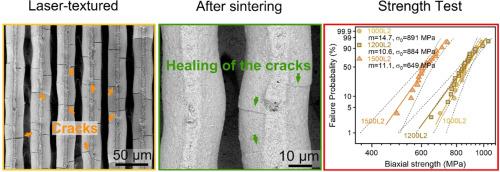Femtosecond laser texturing of crack-free zirconia composites: Texturing of pre-sintered ceramics and microcrack self-healing
IF 14.3
1区 材料科学
Q1 MATERIALS SCIENCE, MULTIDISCIPLINARY
引用次数: 0
Abstract
Laser surface texturing of ceramic components without inducing surface cracking and the concomitant strength degradation remains a significant challenge, limiting its application in high-strength or long-term fatigue resistance conditions. Here, a simple and convenient manufacturing methodology was explored by applying laser texturing on pre-sintered alumina toughened zirconia (ATZ) ceramics instead of fully sintered ones. Surface micro-cracks introduced by texturing were totally healed during the subsequent sintering process, giving rise to crack-free, surface-textured ATZ ceramics. Combined with the toughness improvement by triggering additional secondary phase and phase transformation toughening, the ceramics from this methodology showed a significant higher characteristic fracture strength (∼890 MPa) than their equivalents (∼700 MPa) that were laser-textured in the sintered condition, and are competitive with as-sintered (∼914 MPa) ceramics without surface texturing, which challenges the conventional cognition that laser surface-texturing invariably degrades mechanical strength. In addition, the laser textured ATZ ceramics showed a similar hydrothermal aging resistance as the polished ceramics. Our findings address key challenges in laser surface texturing of crack-sensitive ceramic materials. Achieving crack-free surface patterns is essential for ensuring the reliability of ceramics in applications such as dental implants, where laser-modified surface can enhance osseointegration, while the implants' strength must be ensured for structural support and long-term service stability.

无裂纹氧化锆复合材料的飞秒激光织构:预烧结陶瓷的织构与微裂纹自愈
陶瓷部件的激光表面织构不引起表面开裂和伴随的强度下降仍然是一个重大挑战,限制了其在高强度或长期抗疲劳条件下的应用。本文探索了一种简单方便的制造方法,即在预烧结氧化铝增韧氧化锆(ATZ)陶瓷上应用激光织构代替完全烧结的陶瓷。在随后的烧结过程中,织构引起的表面微裂纹被完全愈合,从而产生无裂纹的表面织构ATZ陶瓷。结合通过触发额外的二次相和相变增韧来提高韧性,该方法制备的陶瓷的特征断裂强度(~ 890 MPa)明显高于在烧结条件下激光织构的等效陶瓷(~ 700 MPa),并且与未表面织构的烧结陶瓷(~ 914 MPa)相竞争。这挑战了传统的认知,即激光表面变形必然降低机械强度。此外,激光织构ATZ陶瓷表现出与抛光陶瓷相似的水热老化性能。我们的研究结果解决了裂纹敏感陶瓷材料激光表面变形的关键挑战。实现无裂纹的表面图案对于确保牙科种植体等应用中陶瓷的可靠性至关重要,在这些应用中,激光修饰表面可以增强骨整合,而种植体的强度必须确保结构支撑和长期使用稳定性。
本文章由计算机程序翻译,如有差异,请以英文原文为准。
求助全文
约1分钟内获得全文
求助全文
来源期刊

Journal of Materials Science & Technology
工程技术-材料科学:综合
CiteScore
20.00
自引率
11.00%
发文量
995
审稿时长
13 days
期刊介绍:
Journal of Materials Science & Technology strives to promote global collaboration in the field of materials science and technology. It primarily publishes original research papers, invited review articles, letters, research notes, and summaries of scientific achievements. The journal covers a wide range of materials science and technology topics, including metallic materials, inorganic nonmetallic materials, and composite materials.
 求助内容:
求助内容: 应助结果提醒方式:
应助结果提醒方式:


